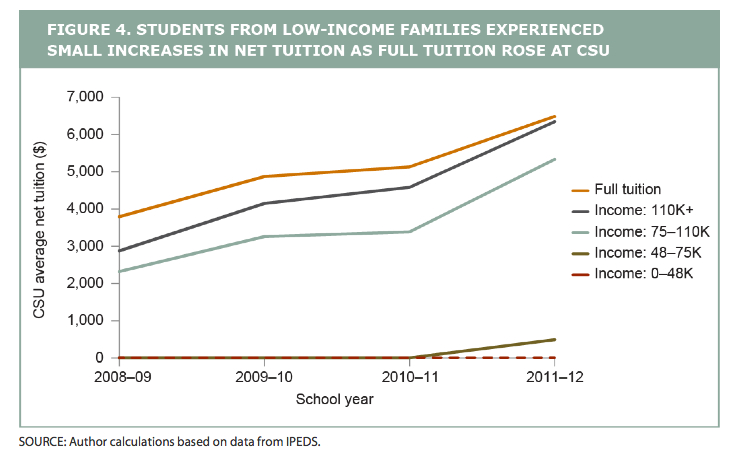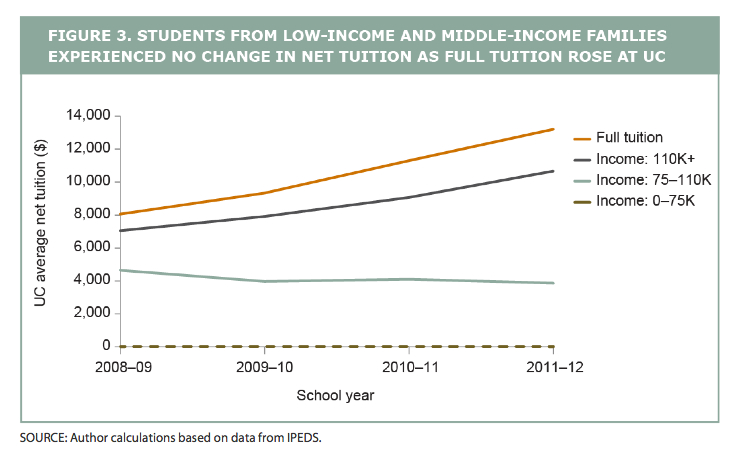 Credit: Public Policy Institute of California.
Credit: Public Policy Institute of California.State and federal financial aid has shielded low-income and some middle class families from the big tuition and fee increases that the University of California and California State University systems enacted after the 2008 recession, but not enough high school students who were eligible for aid sought it, concluded the Public Policy Institute of California in a report released Tuesday. The report recommended actions to extend access to aid to those who qualify.
“Given the importance of higher education to California’s economic future, policymakers at the federal, state, and institutional levels need to make a continuing commitment to keep college affordable for students from low-and middle-income families,” said PPIC, an independent, nonpartisan research organization.
The report comes amid controversy following the announcement by UC trustees last week that they intend to raise tuition an additional 5 percent for each of the next five years unless the Legislature provides more revenue than planned under an agreement the two higher education systems reached two years ago with Gov. Jerry Brown. Brown, student groups and key legislators immediately said they would oppose any increase.

Credit: Public Policy Institute of California.
Students from families earning less than $75,000 have seen small or no increases in CSU tuition, which rose to more than $6,000 by 2011-12.
Only about 30 percent of families – generally, the wealthiest – pay full tuition and fees, according to UC, and that would likely continue if there were increases. The PPIC report found that in 2011-12, the last year of the big post-recession tuition increases, families earning less than $75,000 paid none of the $13,208 average full cost of UC tuition and individual campus fees. CSU families earning less than $48,000 paid no tuition, and families earning between $48,000 and $75,000 paid an average of $495 of the full CSU tuition of $6,486 in 2011-12.
Low-income students can receive up to $5,500 in federal Pell Grants, plus state Cal Grants of $12,192 toward the price of college at UC campuses and $5,472 at CSU campuses. Students also can put the combined aid toward living costs and books.
The estimated average full cost of attending a UC campus in 2011–12 was $30,472; for CSU, it was $19,267. Financial aid has protected most low-income students from increases in non-tuition costs, too, PPIC found.

Credit: Public Policy Institute of California.
UC students from families earning less than $110,000 saw no increase in their costs when tuition rose.
In response to the recession and a plunge in state revenue, the Legislature cut general support for UC and CSU 20 percent, from $6.2 billion in 2007 to $5 billion in 2013. Trustees in both university systems responded by more than doubling tuition. California was ranked 34th in average four-year tuition in 2004; by 2013, it was 21st.
Since then, the two systems agreed to not increase tuition through 2016-17, under an agreement with Brown to restore some of the lost state money. The proposed UC increase would appear to violate that understanding.
In order to receive aid, students must fill out a federal form, the Free Application for Federal Student Aid, known as FAFSA. PPIC said that nationwide more than 10 percent of students from families earning $30,000 to $48,000 and about 20 percent of students from those earning $48,000 to $75,000 fail to fill out the FAFSA, making them ineligible for aid.
A 2013 report from Education Trust-West found big disparities in the percentage of students who completed FAFSA forms among the state’s high schools. Fresno Unified is one of the districts that requires seniors to fill out the FAFSA form. As part of its Long Beach Promise, which guarantees qualified students admission to CSU Long Beach and a semester of free tuition to Long Beach City College, all Long Beach Unified students must pledge to fill out the FAFSA and Cal Grant applications.
PPIC recommended that the state make financial aid forms easier to fill out and create inducements for students to apply. It also suggested that districts include the FAFSA completion rate as a measurement in their Local Control and Accountability Plans, which districts are required to create under the new state funding system.
To get more reports like this one, click here to sign up for EdSource’s no-cost daily email on latest developments in education.














Comments
Comments Policy
We welcome your comments. All comments are moderated for civility, relevance and other considerations. Click here for EdSource's Comments Policy.